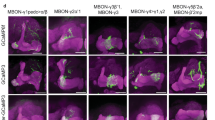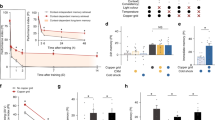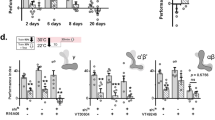Abstract
Volado is a new memory mutant of Drosophila. The locus encodes two isoforms of a new α-integrin, a molecule that dynamically mediates cell adhesion and signal transduction. The Volado gene is expressed preferentially in mushroom body cells, which are neurons known to mediate olfactory learning in insects. Volado proteins are concentrated in the mushroom body neuropil, brain areas that contain mushroom body processes in synaptic contact with other neurons. Volado mutants display impaired olfactory memories within 3 min of training, indicating that the integrin is required for short-term memory processes. Conditional expression of a Volado transgene during adulthood rescues the memory impairment. This rescue of memory is reversible, fading over time along with expression of the transgene. Thus the Volado integrin is essential for the physiological processes underlying memory. We propose a model in which integrins act as dynamic regulators of synapse structure or the signalling events underlying short-term memory formation.
This is a preview of subscription content, access via your institution
Access options
Subscribe to this journal
Receive 51 print issues and online access
$199.00 per year
only $3.90 per issue
Buy this article
- Purchase on Springer Link
- Instant access to full article PDF
Prices may be subject to local taxes which are calculated during checkout






Similar content being viewed by others
References
Byrne, J. H., Zwartjes, R., Homayouni, R., Critz, S. D. & Eskin, A. in Advances in Second Messenger and Phosphoprotein Research (eds Shenolikar, S. & Nairn, A. C.) 47–107 (Raven, New York, 1993).
Chetkovich, D. M., Gray, R., Johnston, D. & Sweatt, J. D. N-methyl-D-aspartate receptor activation increases cAMP levels and voltage-gated Ca2+ channel activity in area CA1 of hippocampus. Proc. Natl Acad. Sci. USA 88, 6467–6471 (1991).
Ghirardi, M.et al. Roles of PKA and PKC in facilitation of evoked and spontaneous transmitter release at depressed and nondepressed synapses in Aplysia sensor neurons. Neuron 9, 479–489 (1992).
Davis, R. L. Physiology and biochemistry of Drosophila learning mutants. Physiol. Rev. 76, 299–317 (1996).
Hawkins, R. D., Kandel, E. R. & Siegelbaum, S. A. Learning to modulate transmitter release: themes and variations in synaptic plasticity. Annu. Rev. Neurosci. 16, 625–665 (1993).
Davis, H. P. & Squire, L. R. Protein synthesis and memory: a review. Psychol. Bull. 96, 518–559 (1984).
Montarolo, P. G.et al. Acritical period for macromolecular synthesis in long-term heterosynaptic facilitation in Aplysia. Science 234, 1249–1254 (1986).
Tully, T., Preat, T., Boynton, S. C. & Del Vecchio, M. Genetic dissection of consolidated memory in Drosophila. Cell 79, 35–47 (1994).
Schacher, S., Castellucci, V. F. & Kandel, E. R. cAMP evokes long-term facilitation in Aplysia sensory neurons that requires new protein synthesis. Science 240, 1667–1669 (1988).
Bailey, C. H. & Kandel, E. R. Structural changes accompanying memory storage. Annu. Rev. Physiol. 55, 397–426 (1993).
Davis, R. L. Mushroom bodies and Drosophila learning. Neuron. 11, 1–14 (1993).
Davis, R. L. & Han, K.-A. Mushrooming mushroom bodies. Curr. Biol. 6, 146–148 (1996).
Feany, M. S. & Quinn, W. G. Aneuropeptide gene defined by the Drosophila memory mutant amnesiac. Science 268, 869–873 (1995).
Yin, J. C. P.et al. Induction of a dominant negative CREB transgene specifically blocks long-term memory in Drosophila. Cell 79, 49–58 (1994).
Grant, S. C. & Silva, A. J. Targeting learning. Trends Neurosci. 17, 71–75 (1994).
Alberni, C. M., Ghirardi, M., Metz, R. & Kandel, E. R. C/EBP is an immediate-early gene required for the consolidation of long-term facilitation in Aplysia. Cell 76, 1099–1114 (1994).
Mello, C. V. & Clayton, D. F. Differential induction of the ZENK gene in the avial forebrain and song control circuit after metrazole-induced depolarization. J. Neurobiol. 26, 145–161 (1995).
Huston, J. P. & Hasenohrl, R. U. The role of neuropeptides in learning: focus on the neurokinin substance P. Behav. Brain Res. 66, 117–127 (1995).
Zhuo, M., Hu, Y., Schultz, C., Kandel, E. R. & Hawkins, R. D. Role of guanylyl cyclase and cGMP-dependent protein kinase in long-term potentiation. Nature 368, 635–649 (1994).
Hynes, R. O. Integrins: Versatility, modulation, and signalling in cell adhesion. Cell 69, 11–25 (1992).
Han, P.-L., Meller, V. & Davis, R. L. The Drosophila brain revisited by enhancer detection. J. Neurobiol. 31, 88–102 (1996).
Skoulakis, E. M. C. & Davis, R. L. Olfactory learning deficits in mutants for leonardo, a Drosophila gene encoding a 14-3-3 protein. Neuron 17, 931–944 (1996).
Kretsinger, R. H. Structure and evolution of calcium-modulated proteins. CRC Crit. Rev. Biochem. 8, 119–174 (1980).
Barr, P. J. Mammalian subtilisins: the long-sought dibasic processing endoproteases. Cell 66, 1–3 (1991).
Diamond, M. S. & Springer, T. A. The dynamic regulation of integrin adhesiveness. Curr. Biol. 4, 506–517 (1994).
Dedhar, S. Novel functions for calreticulin: interaction with integrins and modulation of gene expression? Trends Biochem. Sci. 19, 269–307 (1994).
Bausenwein, B., Muller, N. R. & Heisenberg, M. Behaviour-dependent activity labeling in the central complex of Drosophila during controlled visual stimulation. J. Comp. Neurol. 340, 255–268 (1994).
Nighorn, A., Healy, M. J. & Davis, R. L. The cyclic AMP phosphodiesterase encoded by the Drosophila dunce gene is constructed in the mushroom body neuropil. Neuron 6, 455–467 (1991).
Han, P.-L., Levin, L. R., Reed, R. R. & Davis, R. L. Preferential expression of the Drosophila rutabaga gene in mushroom bodies, neural centers for learning in insects. Neuron 9, 619–627 (1992).
Skoulakis, E. M., Kalderon, D. & Davis, R. L. Preferential expression in mushroom bodies of the catalytic subunit of protein kinase A and its role in learning and memory. Neuron 11, 197–208 (1993).
Han, K.-A., Millar, N., Grotewiel, M. S. & Davis, R. L. DAMB, a novel dopamine receptor expressed specifically in Drosophila mushroom bodies. Neuron 16, 1127–1135 (1996).
Sastry, S. K. & Horwitz, A. F. Integrin cytoplasmic domains: mediators of cytoskeletal linkages and extra- and intracellular initiated transmembrane signalling. Curr. Opin. Cell Biol. 5, 819–831 (1993).
Clark, E. A. & Brugge, J. S. Integrins and signal transduction pathways: The road taken. Science 268, 233–239 (1955).
Zhang, Z., Vuori, K., Wang, H.-G., Reed, J. C. & Ruoslahti, E. Integrin activation by R-ras. Cell 61–69 (1996).
Staubli, U., Vanderklish, P. & Lynch, G. Rapid Communication: An inhibitor of integrin receptors blocks long-term potentiation. Behav. Neur. Biol. 53, 1–5 (1990).
Bahr, B. A.et al. Arg-gly-asp-ser-selective adhesion and the stabilization of long-term potentiation: pharmacological studies and the characterization of a candidate matrix receptor. J. Neurosci. 17, 1320–1329 (1997).
Chen, B.-M. & Grinnel, A. D. Integrins and modulation of transmitter release from motor nerve terminals by stretch. Science 269, 1578–1580 (1995).
Jones, L. S. Integrins: possible functions in the adult CNS. Trends Neurosci. 19, 68–72 (1996).
Pirrotta, V. in Drosophila, A Practical Approach (ed. Roberts, D. B.) 83–110 (IRL Press, Oxford, 1986).
Zhang, S. D. & Odenwald, W. F. Misexpression of the white (w) gene triggers male-male courtship in Drosophila. Proc. Natl Acad. Sci. USA 92, 5525–5529 (1995).
Hing, A. L. & Carlson, J. R. Male-male courtship behavior induced by ectopic expression of the Drosophila white gene: role of sensory function and age. J. Neurobiol. 30, 454–464 (1996).
Lindman, H. R. Analysis of Variance in Experimental Design (Springer, New York, 1992).
Acknowledgements
We thank members of the R. L. Davis laboratory, R. Montague and D. Sweatt for comments on the manuscript; R. Latorre and P. Labarca for suggesting the name Volado; and E. Chen, S.Swanson, B. Schroeder and S. Ahmed for technical assistance. This work was supported by NRSAs (M.S.G., C.D.O.B.) and research grants from the NIH and the R.P. Doherty-Welch Chair in Science (R.L.D.).
Author information
Authors and Affiliations
Corresponding author
Supplementary Information
Rights and permissions
About this article
Cite this article
Grotewiel, M., Beck, C., Wu, K. et al. Integrin-mediated short-term memory in Drosophila. Nature 391, 455–460 (1998). https://doi.org/10.1038/35079
Received:
Accepted:
Issue Date:
DOI: https://doi.org/10.1038/35079
This article is cited by
-
Galectin-3 promotes Aβ oligomerization and Aβ toxicity in a mouse model of Alzheimer’s disease
Cell Death & Differentiation (2020)
-
The central role of heat shock factor 1 in synaptic fidelity and memory consolidation
Cell Stress and Chaperones (2016)
-
Glycoproteomic and glycomic databases
Clinical Proteomics (2014)
-
Fak56 functions downstream of integrin alphaPS3betanu and suppresses MAPK activation in neuromuscular junction growth
Neural Development (2008)
Comments
By submitting a comment you agree to abide by our Terms and Community Guidelines. If you find something abusive or that does not comply with our terms or guidelines please flag it as inappropriate.



